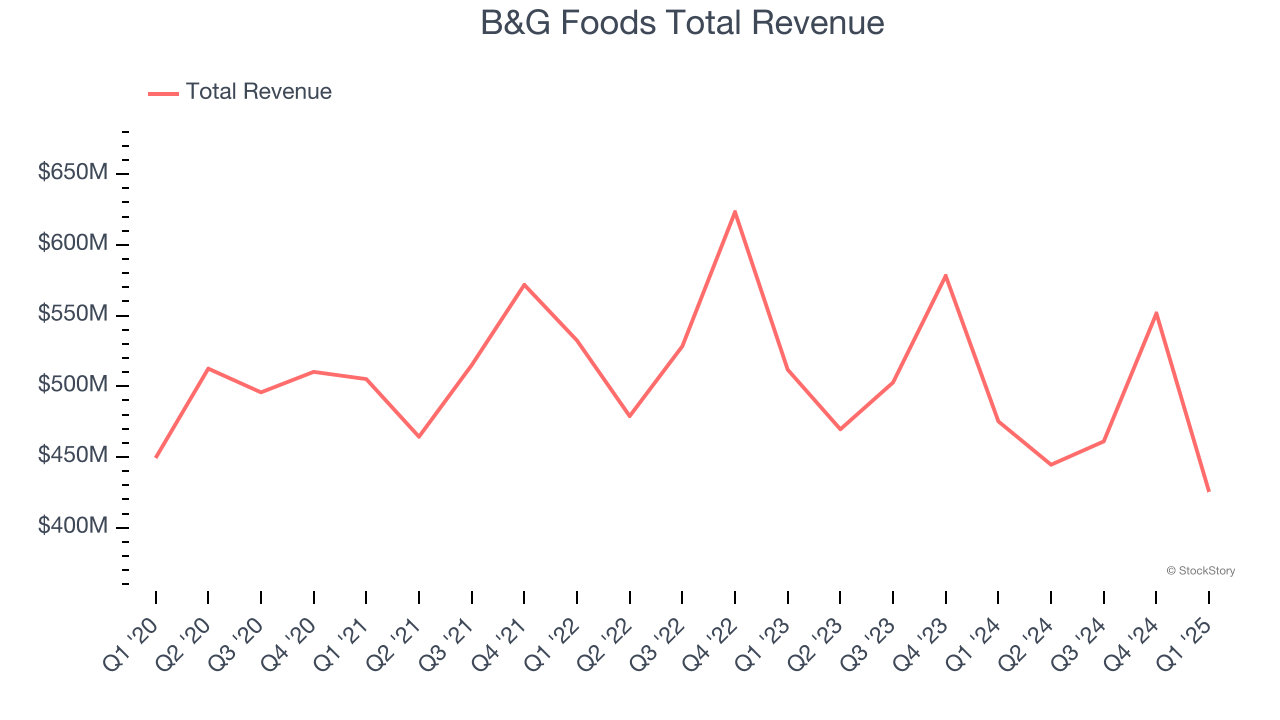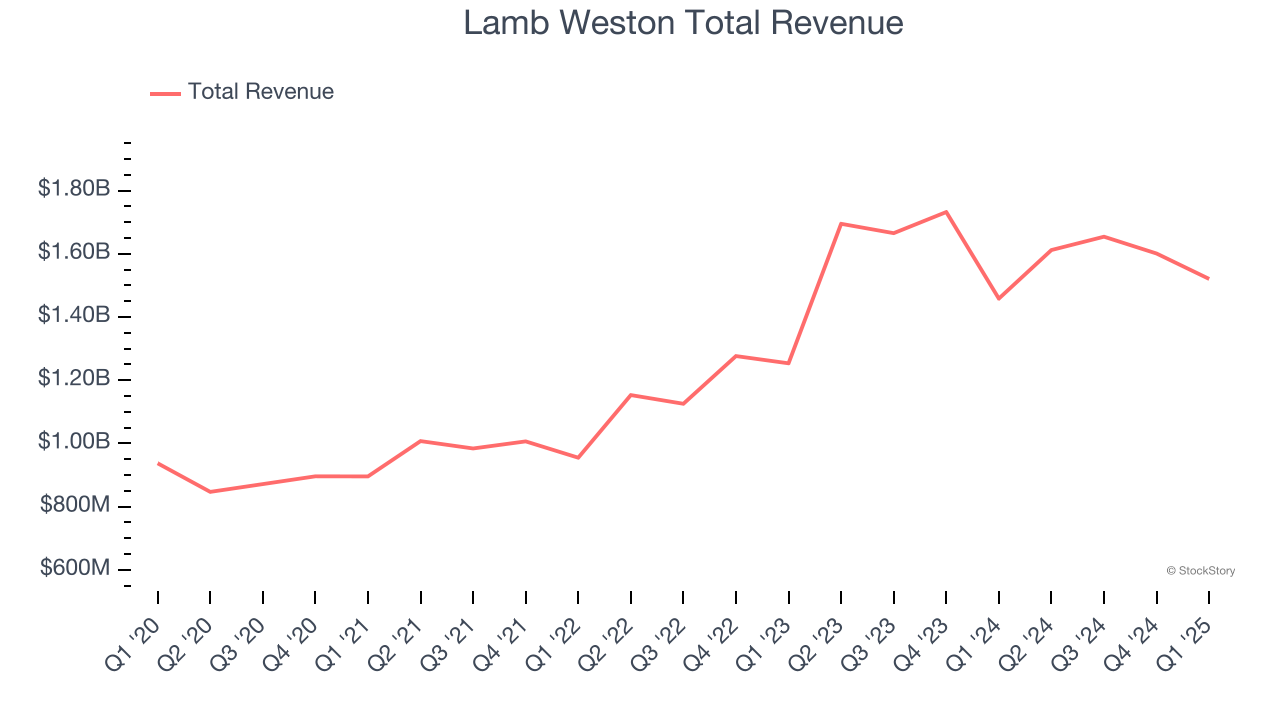
As the craze of earnings season draws to a close, here’s a look back at some of the most exciting (and some less so) results from Q1. Today, we are looking at shelf-stable food stocks, starting with B&G Foods (NYSE: BGS).
As America industrialized and moved away from an agricultural economy, people faced more demands on their time. Packaged foods emerged as a solution offering convenience to the evolving American family, whether it be canned goods or snacks. Today, Americans seek brands that are high in quality, reliable, and reasonably priced. Furthermore, there's a growing emphasis on health-conscious and sustainable food options. Packaged food stocks are considered resilient investments. People always need to eat, so these companies can enjoy consistent demand as long as they stay on top of changing consumer preferences. The industry spans from multinational corporations to smaller specialized firms and is subject to food safety and labeling regulations.
The 18 shelf-stable food stocks we track reported a slower Q1. As a group, revenues missed analysts’ consensus estimates by 1% while next quarter’s revenue guidance was 0.5% above.
Amidst this news, share prices of the companies have had a rough stretch. On average, they are down 8.9% since the latest earnings results.
Weakest Q1: B&G Foods (NYSE: BGS)
Started as a small grocery store in New York City, B&G Foods (NYSE: BGS) is an American packaged foods company with a diverse portfolio of more than 50 brands.
B&G Foods reported revenues of $425.4 million, down 10.5% year on year. This print fell short of analysts’ expectations by 6.8%. Overall, it was a disappointing quarter for the company with a significant miss of analysts’ adjusted operating income estimates.
Commenting on the results, Casey Keller, President and Chief Executive Officer of B&G Foods, stated, “Our first quarter results reflect the challenging environment in the packaged foods industry at the start of 2025, including the impact of retailer inventory reductions and a shift in Easter timing into the second quarter. While January and February were especially difficult, recent net sales in March, April and early May have begun to show stabilizing trends versus last year. We remain laser focused on our critical priorities: improving our core business net sales trends, reshaping our portfolio for future growth and higher margins, and reducing leverage through divestitures and excess cash flow to facilitate strategic acquisitions. We have also accelerated our cost reduction efforts and expect to achieve significant cost savings during the remainder of the year.”

B&G Foods delivered the weakest performance against analyst estimates of the whole group. Unsurprisingly, the stock is down 35.1% since reporting and currently trades at $4.10.
Read our full report on B&G Foods here, it’s free.
Best Q1: Lamb Weston (NYSE: LW)
Best known for its Grown in Idaho brand, Lamb Weston (NYSE: LW) produces and distributes potato products such as frozen french fries and mashed potatoes.
Lamb Weston reported revenues of $1.52 billion, up 4.3% year on year, outperforming analysts’ expectations by 2.4%. The business had a very strong quarter with an impressive beat of analysts’ EBITDA estimates and a solid beat of analysts’ gross margin estimates.

Lamb Weston delivered the highest full-year guidance raise among its peers. Although it had a fine quarter compared its peers, the market seems unhappy with the results as the stock is down 5.8% since reporting. It currently trades at $51.02.
Is now the time to buy Lamb Weston? Access our full analysis of the earnings results here, it’s free.
J&J Snack Foods (NASDAQ: JJSF)
Best known for its SuperPretzel soft pretzels and ICEE frozen drinks, J&J Snack Foods (NASDAQ: JJSF) produces a range of snacks and beverages and distributes them primarily to supermarket and food service customers.
J&J Snack Foods reported revenues of $356.1 million, down 1% year on year, falling short of analysts’ expectations by 3.2%. It was a disappointing quarter as it posted a significant miss of analysts’ adjusted operating income estimates.
As expected, the stock is down 10.5% since the results and currently trades at $118.23.
Read our full analysis of J&J Snack Foods’s results here.
BellRing Brands (NYSE: BRBR)
Spun out of Post Holdings in 2019, Bellring Brands (NYSE: BRBR) offers protein shakes, nutrition bars, and other products under the PowerBar, Premier Protein, and Dymatize brands.
BellRing Brands reported revenues of $588 million, up 18.9% year on year. This print topped analysts’ expectations by 1.6%. More broadly, it was a mixed quarter as it also logged a solid beat of analysts’ organic revenue estimates but a significant miss of analysts’ gross margin estimates.
BellRing Brands achieved the fastest revenue growth but had the weakest full-year guidance update among its peers. The stock is down 22.8% since reporting and currently trades at $60.63.
Read our full, actionable report on BellRing Brands here, it’s free.
Hershey (NYSE: HSY)
Best known for its milk chocolate bar and Hershey's Kisses, Hershey (NYSE: HSY) is an iconic company known for its chocolate products.
Hershey reported revenues of $2.81 billion, down 13.8% year on year. This number was in line with analysts’ expectations. Taking a step back, it was a satisfactory quarter as it also recorded an impressive beat of analysts’ EBITDA estimates but a significant miss of analysts’ gross margin estimates.
Hershey had the slowest revenue growth among its peers. The stock is down 7.9% since reporting and currently trades at $154.15.
Read our full, actionable report on Hershey here, it’s free.
Market Update
Thanks to the Fed’s series of rate hikes in 2022 and 2023, inflation has cooled significantly from its post-pandemic highs, drawing closer to the 2% goal. This disinflation has occurred without severely impacting economic growth, suggesting the success of a soft landing. The stock market thrived in 2024, spurred by recent rate cuts (0.5% in September and 0.25% in November), and a notable surge followed Donald Trump’s presidential election win in November, propelling indices to historic highs. Nonetheless, the outlook for 2025 remains clouded by potential trade policy changes and corporate tax discussions, which could impact business confidence and growth. The path forward holds both optimism and caution as new policies take shape.
Want to invest in winners with rock-solid fundamentals? Check out our Top 5 Quality Compounder Stocks and add them to your watchlist. These companies are poised for growth regardless of the political or macroeconomic climate.
Join Paid Stock Investor Research
Help us make StockStory more helpful to investors like yourself. Join our paid user research session and receive a $50 Amazon gift card for your opinions. Sign up here.
